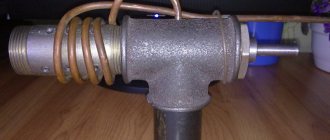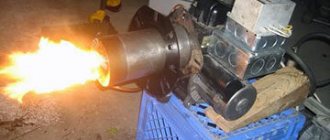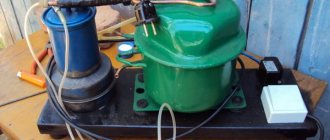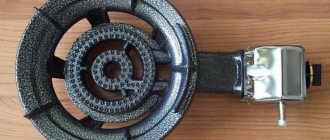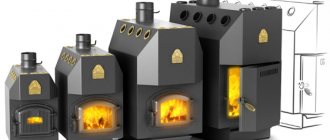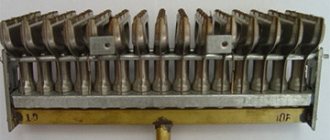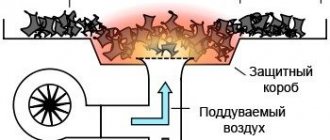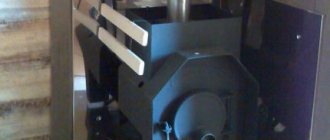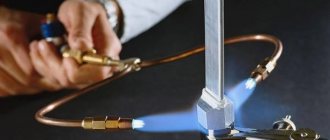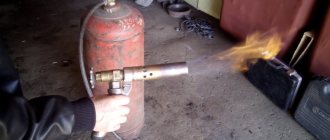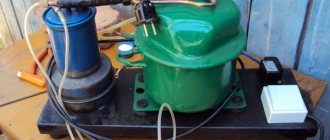The modern market offers customers a huge selection of all kinds of heating equipment options, which differ from each other, both in quality and in their reliability. Both the quality and durability of any technological equipment largely depend on the parts and materials from which it was created.
If we talk about heating devices, then a diesel burner plays a very important role in their design, without which no device would function properly. It is also necessary to emphasize that diesel fuel burners can be produced in various modifications, so the features of their design should be taken into account in order to choose exactly what you need.
Do-it-yourself waste oil burner manufacturing features
The easiest way to make a burner is using a small gas cylinder or a blowtorch. To work you need to prepare:
- the above container;
- welding machine;
- grinder;
- a piece of 1.5-inch pipe;
- a round plate equal to the inner diameter of the pipe;
- a piece of wire 6 - 8 mm;
- bolt with a through internal hole for the oil supply nozzle;
- a thick round blank for the lid.
Beginning of work
- Two holes are drilled tangentially in the cylinder: from the bottom (for the mixture of air and oil to enter), and from the top for the flame to exit. Tubes with a diameter of 1.5 inches are welded. One is a continuation of the other, only a little higher; so that the fire swirls inside and does not immediately fly out into the street.
- An ignition hatch is made on top and equipped with a heavy lid so that it does not open during operation due to the pressure of incoming air.
Air flow control
The pressure and amount of air supplied for combustion is regulated by a homemade damper (it is made according to the throttle principle, like in a carburetor).
The flap is installed in the supply pipe upstream of the fuel injector as follows:
- A hole for the rotary axis is drilled strictly according to the diameter of the existing workpiece.
- A round plate is cut along the inner diameter of the pipe, which in the closed position can completely block the hole.
- A rotary axis is made in the shape of the letter “L” and a damper is mounted on it with small bolts.
- In front of the damper, a hole is drilled or a slot is cut in the supply pipe to remove “excess” air (in case there is a lot of it for the burner).
The principle of feeding waste into the burner itself
To supply oil, a diffuser is installed in the intake pipe immediately behind the damper. The diffuser is a chiseled ring insert that slightly narrows the flow area. Thanks to it, a vacuum is created and oil (or other liquid fuel) flows through the nozzle and mixes with air.
For the supply pipeline, it is preferable to use metal pipes. A freon tank is well suited for the fuel tank, and the needle valve allows you to precisely regulate the oil supply.
Simple homemade burner
The oil must be separated from water and filtered.
Principle of operation
The fuel is supplied by gravity to the nozzle and is sucked in by air passing through the diffuser. The resulting mixture ignites inside the cylinder, and the torch is blown outside. Thus, the source of heat is the burner itself (heats up to a crimson glow) and the torch.
The flame can even be used to melt some metals such as copper, aluminum and others that have a lower melting point.
Let's start making our own
- welding machine;
- Bulgarian;
- lathe.
In appearance, the burner looks like a small empty gas cylinder, with oppositely directed steel pipe sections welded on the top and bottom sides of it. The inside of the burner measures only 1 inch (2.54 cm) and its walls are quite large.
A piece of pipe at the bottom is required to supply oil and air to the part where combustion occurs. The short pipe at the top is used as the burner mouth from which the flame will erupt.
Expert tip: To set the air flow into the oven, a regular high-power household vacuum cleaner can be used.
Drilling holes
In order for the air flow to atomize the fuel as efficiently as possible, the hole should be as small in diameter as possible. The priority is 0.010 inches. Although holes up to 0.020 in size are also considered acceptable. To obtain them, special thin drills are used. If you look at them from the side, they will seem intermittent. In any case, the drilling process should be done slowly and carefully. Compressed air will flow through these holes.
As for spraying using air, this option is more preferable than gas. This is due to the low cost of the resource. While you have to pay for gas, you don’t have to pay for air. In addition, you need very little of it, so you can use ordinary compressors, such as those used on aquariums. In principle, the Babington burner, the drawings of which you can find in this article, is almost ready for use. There are a few small parts left.
Combustion conditions
In order for a homemade burner to work during mining, several requirements must be met.
In particular, oil will burn best when heated and atomized. It is not difficult to fulfill these conditions; the article provides several options for burners that have a powerful flame of fire, and most importantly, a large amount of thermal energy is released. It should be noted that it is allowed to fulfill at least one condition - to provide heating or atomization. True, the efficiency will be somewhat less.
Do it yourself
The process of making a Babington burner is not very complicated and, if you have all the necessary materials and tools, it will only take a few days, depending on the skills of the person.
To manufacture this unit you will need the following materials:
- steel tube DN10,
- metal tee with a diameter of 50 millimeters with internal thread;
- a metal sphere (or hemisphere) with a diameter of less than 50 millimeters;
- copper tube DN10 at least one meter long;
- metal elbow DN10 with external thread;
- a bend with a diameter of 50 millimeters with an external thread, a length of at least 10 centimeters;
You will also need a minimum set of tools:
- angle grinder (grinder) or hacksaw for metal;
- perforator;
- special chuck for thin drills;
- drill;
- drill with a diameter of 0.1–0.3 millimeters;
- soldering iron;
Preparatory stage
Before starting assembly, you need to make a hole in the sphere (hemisphere). This is one of the most difficult and critical stages, since the hole must be made exactly in the middle. Otherwise, the burner torch will be directed to the side, which in turn can negatively affect the quality of the product and its efficiency.
In addition, drilling holes of this diameter is a difficult task, since thin drills can break. Therefore, this process must be carried out carefully and slowly.
Step-by-step instruction
Once the sphere or hemisphere is ready, you can begin assembly. It is very simple and consists of several simple manipulations:
- The metal squeegee will act as a nozzle. It is cut to the required length and screwed into the tee. After this, a hole is drilled in the side of the burner, large enough so that the jet can be ignited through it.
- On top of the tee, closer to the nozzle, a hole is made for a copper tube through which fuel will be supplied to the device.
- An elbow is attached to the copper tube to connect the fuel line.
- A copper tube makes several turns (2-3 will be enough) around the nozzle. They must be done at some distance from the drive. This will allow the oil to be heated to the desired temperature before it hits the sphere.
- In the sphere, at the opposite end of the small hole, another hole is drilled along the outer diameter of the steel tube. The tube is hermetically inserted into the sphere. This is necessary so that the air exits only through a small hole, and pressure is created inside it. If a hemisphere is used instead of a sphere, then the tube is soldered at the small hole and sealed.
- From the opposite end from the nozzle, a metal tube with a sphere is inserted into the tee. She is fixed in it.
- Thus, the burner is ready for use. All that remains is to connect a compressor to the tube with the sphere, which will pump air into it and a fuel line to the copper tube.
- If desired, this system can be improved by connecting a pump to supply oil. You can also install a control unit with control sensors. This will make this system automatic and more secure.
Requirements for installing a diesel boiler
- The boiler must be installed only in a separate room with an area of at least 8 sq.m. and the maximum ceiling height is no more than 2.5 m.
- The room must have a good ventilation system, since diesel fuel or diesel fuel has a persistent unpleasant odor, which can be harmful to humans if its concentration is high in the air. If you want to place a lot of heating devices in it, then take care of strengthening the foundation of the room.
- Access to the boiler must be problem-free for maintenance. The distance from the walls of the boiler to the walls of the room should be at least 40-50 cm.
- Separately about the ventilation system. It is calculated as follows: for each kilowatt of the boiler, 8 cubic cm should be supplied. fresh air. You should also not forget that the entrance to the ventilation should be located under the ceiling, and the chimney opening should be in the wall.
- The chimney must be sealed and gas-tight. To meet this condition, it is necessary to cover it with a dense layer of plaster or lay an asbestos-cement pipe inside.
Fuel supply
Amateur craftsmen often supply drip furnaces with single-stage fuel: an oil tank, a ball valve, and a supply tube. Firstly, this is dangerous: for convenience and safety of starting the stove, the valve must be placed closer to it. The supply tube gets quite hot when fuel is supplied from the bottom. If the heating passes through the pipe past the valve, up to which there is a solid column of fuel in the pipe, this could lead to disaster. Secondly, the fuel supply to the furnace is unstable: as the tube warms up, the drops become more frequent, because the oil thins out. If it flows in a trickle, then it is again dangerous.
The drip supply of oil to the furnace during processing should be organized according to a 2-stage scheme: main (storage) oil tank - valve - supply dropper - supply tank (tank) - free flow from it at least 60 mm from the bottom (for additional sedimentation of sludge) - working dropper. The fuel supply is opened when the kindling in the bowl (see below) is lit. While the oil drips into the tank to the level of the drain, you can slowly adjust its flow, and then it drips into the bowl drop by drop.
Scheme of safe power supply of a drip furnace from a supply tank with a safety valve and capillary
This system, however, is not completely safe. If in a hurry, out of ignorance, or simply trying to quickly warm up from the cold, open the valve too much, the consumables will immediately fill, fuel will rush into the stove, and it will throw out a tongue of fire and start spitting burning spray. It would be correct to build a drip oil supply system into the furnace with a safety float valve and a metering capillary (see figure on the right).
Since different metals are wetted by waste in different ways, and its properties vary significantly from batch to batch, the length of the capillary will need to be selected: the oil is fed under a gravitational pressure of 120-150 mm (from a suspended container) at room temperature, and the capillary is selected so that it drips more often, but with drops clearly visible to the eye. A diesel fuel drip furnace can be used from the same feeder, but the capillary will need to be taken with a clearance of 0.6-1 mm and a length 2.5-3 times longer than for mining. There is only one drawback to this scheme for supplying fuel to a drip furnace: the exhaust is dirty fuel, and the capillary will have to be cleaned periodically.
Dripper stove under development
One of the types of inexpensive fuel is used oil. The stove can heat up to 800-900 °C. At the outlet the temperature will be 90 °C.
Pour a portion of oil and add 50-100 g of ignition agent (special fluid, stove fuel, kerosene or diesel fuel). This is necessary to quickly ignite the stove. Wait until the combustion process stabilizes. Then you can pour in the next portion.
If there is any spilled oil, it should be removed immediately. Combustion occurs in the middle of the pipe. This is a safe process. Fuel consumption is from 0.5 to 1.5 liters per hour. When the stove lights up, you can heat the water.
Dripper stove under development
Recommended for use: diesel oil, fuel oil, waste oil, stove fuel. Do not use gasoline, acetone or other solvents. Water penetration into the fuel must be avoided.
In the specialized literature there are a huge number of detailed guides on how to make a drip oven with your own hands. Each of these designs is unique and has its own pros and cons. You can also use a store-bought version of the stove, but modify it at your own discretion.
Watch an overview video about the diesel drip stove:
Nozzle
First you need to make a spherical nozzle; fuel will flow through it in the future. Make a hole in the sphere, the diameter should be approximately 0.25 mm
Please note that the power of a homemade burner depends on the diameter. The smaller the diameter, the lower the power and vice versa
All difficulties await you in the manufacture of the nozzle. The channel for air passage must be made perfectly smooth. It is necessary that the air hits forward and not against the walls of the nozzle. The best option is to make a hole on a special machine.
But if luck smiles on you and you find a jet with the desired diameter, then do not miss the opportunity and place it in the center of the spherical element. If you can’t find a hemisphere, you can use a small piece of sheet metal with a jet attached inside. As a result, you will receive an oil spray nozzle. Heated fuel will flow into it, and atomization occurs due to the incoming air. When installing such a device in a universal boiler, you get an effective and cheap heat source.
Advantages and disadvantages of a liquid fuel burner
This equipment has a lot of advantages, the main ones are:
- Easy to make with your own hands and use.
- Wide distribution of drawings for the manufacture of fixtures.
- Cheapness of used oil used as fuel. These devices are perfect for transport organizations and companies where there is a lot of waste. In this way, waste can be disposed of and space heating can be carried out.
- Efficiency and functionality of devices.
- Mobility of the device.
Despite the listed advantages, the burner also has a drawback. It is quite demanding on the quality of used oil.
Principle of operation
In most known oil burners, the oil-air mixture is supplied through a nozzle under pressure. In contrast, in the Babington system, oil is supplied by a low-pressure pump and flows freely over a surface shaped like a sphere or close to it. The fuel forms a thin film and evaporates, carried away by a stream of air supplied under pressure into a small (up to 0.3 millimeter) hole in the center of the sphere. Oil vapor and air mix, forming a torch of the fuel mixture. This torch is ignited and heats what needs to be heated - the walls of the furnace or the liquid heat exchanger of the boiler.
Operating principle
Some of the oil does not have time to evaporate and burn and flows below the hole, ending up in the fuel collection pan. The waste then flows from the sump into the fuel tank and is reused.
To increase the fluidity and volatility of the mining, it is heated. The heated waste is sprayed into droplets of a smaller volume, which also improves the quality of the fuel mixture and the overall efficiency of the device.
Device diagram
The main element of the Babington burner is a hollow part with an inclined or spherical surface, with a hole with a diameter of about 0.3 mm in the center. Using a pump with a small pressure, fuel is supplied to this surface and flows down it, so that as a result a thin film is formed on the part.
From the inside, a compressor supplies the part with compressed air (pressure - from 2 to 4 atm), which comes out through that very small hole. At the same time, it tears off a certain area of the oil film from the spherical surface, forming with it a flow of the fuel-air mixture.
All that remains is to set it on fire so that the Babington burner starts working and starts producing heat. Ignition is carried out, as in a conventional burner, using a spark. To do this, a homemade burner must be equipped with a car spark plug.
Babington burner drawing
That part of the fuel that did not take part in the combustion process flows down the part into the pan, and from it back into the fuel tank.
In order for the characteristics of a homemade Babington burner to be the best, it should be equipped with a heating system in which the fuel will be heated before entering the work surface. Thanks to this, it will become more fluid, and accordingly, the film it forms will be thinner. Thus, the degree of atomization will be the highest, so the burner will light up easily and work with maximum efficiency (fuel will burn in full).
From the principle of operation it is clear that the Babington burner really does not need a filter. No matter how many impurities are contained in the fuel, it will function properly. However, before refueling the burner, it is better to pass the used oil through a fine-mesh mesh.
Burners for gas boilers can be purchased, or you can make them yourself. Do-it-yourself gas burner for a boiler - basic requirements for manufacturing and operation.
What to do if the gas water heater stops lighting? This information will help you understand the causes and troubleshooting methods.
Finished equipment
HVAC and heating equipment stores sell burners using waste fuel (oil). An analogue of real stores are online portals for selling equipment. The list of available burners in terms of power and capabilities is extremely wide, as is the price range. The majority of the market is occupied by the following manufacturers:
- The stove is a “Gnome” class burner. Price niche from 40 thousand rubles. up to 450 thousand. Power range 35 - 1000 kW. Comparable to Amalthea burners.
- NORTEC is the most popular Chinese manufacturer. Budget options for 60 kW cost 75 thousand rubles. There are universal models of 1500 kW and costing more than 570 thousand rubles.
- Euronord is another Chinese company, the range of burners is 40 - 236 kW, priced at 90 - 150 thousand rubles. respectively.
- The domestic company Olympia has the highest price, up to 780 thousand rubles. for 500 kW, but the manufacturer has a RosTest certificate.
For the most part, store burners are ejection devices equipped with automatic systems, fuel heating and safety sensors. All control is carried out from an electronic remote control. There is also equipment for attachment to a boiler or heater. As you can see, even the most budget options have a decent price.
Starting the furnace
It has already been said implicitly that you need to start the drip furnace slowly and smoothly. Usually, for this they use a torch made from a knitting needle with a piece of foam rubber or a rag: let some drops in and place the torch. When it gets wet, they wait until a puddle drips into the bowl, light a torch, and pour oil into it.
There is a much more convenient and safer way to start a drip stove: a wad of toilet paper soaked in the same oil. They put it in a bowl, set it on fire and slowly regulate the drips, no longer worrying about kindling. Toilet paper is almost pure cellulose; it burns without leaving a residue. Tourists have been warming themselves in tents this way for a long time: the roll is inserted into a wood chip stove, poured with half a glass of alcohol (which also burns without a trace), or the whole thing, darling, and set on fire from above. A lot of heat is generated, and an insignificant amount of fluffy ash can simply be blown out. In the oven it will fly out into the chimney.
Additional Tips
When using a homemade burner, there are usually increased requirements for compliance with fire safety rules
Important to remember:
- Do not leave a working nozzle unattended.
- It is prohibited to install the equipment in a residential area.
- To heat the heating main boiler, a special room is usually made without flammable coating on the walls, ceiling and floor.
- To increase operating efficiency, heavily contaminated waste is enriched with clean oil.
- Reliable ventilation is built in the boiler room to remove gases and smoke after fuel combustion.
- Carry out regular maintenance and equipment reliability checks.
If used correctly, a homemade burner will last for many years. The savings from using this type of heating are obvious, because the used oil has already been paid for, and if not for the homemade firebox, it would have to be disposed of.
Characteristics
A stove assembled with your own hands has a number of advantages:
- it saves fuel;
- if you wish, you can build a stove of different sizes, which will be the best option for this room;
- easy to transport;
- ease of use;
- The oven dripper can be used for cooking food. To do this, at the design level of the stove, the pipe is installed on the side.
Diagram of a diesel-powered dropper stove. This is a very economical design. Absolute combustion of compounds occurs in the furnace chamber
When making a drip stove with your own hands, you must follow fire safety precautions:
- the device must be located in a draft-free room;
- there should be no flammable objects near the stove; it is best to have free space next to it (about half a meter);
- Do not use water to extinguish or cool the stove.
Materials that will be required to build the furnace:
- sheet metal;
- copper pipe;
- pipe section;
- rubber hose;
- gas cylinder;
- screws;
- medical burner.
The key tools that will be useful for the job are an inverter unit, a drill and a clamp.
A common device made with your own hands is a drip stove made from a gas cylinder
DIY Babington burner
A worthy alternative to store-bought burners would be to make your own waste oil burner. First you need to decide on the type of device. Ejection circuits are difficult for home production, and evaporation circuits have a limited scope of application. This means that the best option would be the Babington device, which was originally intended to run on diesel fuel.
The key operating principle of this burner is that a stream of compressed air is supplied directly through the waste layer. Also, the device does not have bottlenecks that could become clogged with dirt. To create burner units you will need the following materials:
- The fuel unit is a tank with a heating element with a power of up to 1 kW made of stainless metal. A sump with a pipe, a drain with an inch thread and a 2/1-inch adapter for draining excess waste oil into the tank. Copper tube with a diameter of 1 cm and a thickness of up to 0.15 cm. An oil pump with an electric motor, equipped with an oil filter with a large mesh (can be removed from a car or motorcycle).
- Pneumatic unit - a compressor with a permissible pressure of 2-4 atm., a tube for an air stream with a diameter of 1-1.5 cm.
- The fuel-air mixing chamber is an empty metal ball or hemisphere with sufficient thickness for a 0.3 mm hole (nut with a plug, brass door handle, etc.).
- A nozzle that directs the flame in the desired direction. Length 20-40 cm, external thread with a diameter of 2 inches.
- Connecting parts (fittings) and transition parts (adapters) allowing you to assemble the entire unit into a single burner.
Preparing burner modules for assembly
The role of the key part is given to the hemisphere in which the used oil is mixed with oxygen. You need to drill a hole in it, which affects the power of the future burner. For a 15 kW heating boiler, a nozzle with a single hole of 0.2 mm is suitable. Greater burner power can be achieved with 3-4 holes of 0.1-0.25 mm, with a mandatory distance of 0.8-1 cm (so the torches from each hole will not extinguish each other). One quarter-centimeter hole consumes 2 liters of waste oil per hour of operation.
The fuel tank is made of corrosion-resistant metal, as is the fuel sump. The latter is equipped with a tube through which waste oil flows back into the tank. A plug is made at the bottom of the sump to drain the dirty residue. A heating element equipped with a regulator is built into the tank, which will turn it off at 70°C.
The role of the body is played by a cross or tee, to which the nozzle and adapters are mounted. At the top there is an oil supply, at the rear there is a compressed air supply, at the bottom there is an adapter for draining excess fuel. The role of adapters is played by plugs with holes for air and oil supply pipes.
The pump motor for supplying waste is connected to a network with a voltage of 220V. Oil (waste) from the tank flows through a copper tube, on the one hand, wound three times around the nozzle, and on the other, led into the tank through an oil filter.
The air tube is attached to a hemisphere with a drilled nozzle and a plug adapter is installed. The hemisphere itself is positioned in such a way that the fuel from the copper fuel tube completely covers the nozzle, and the remainder flows into the sump. The duct compressor is also connected to the household network.
Preparing fuel for the burner
A device operating on waste oil consumes any type of waste. Motor oils with high water content are mixed with diesel fuel (or clean oil) before filling. Mining with moderate contamination can be poured immediately.
It is advisable to let edible oils stand before use, then drain the remainder. Fuel oil and viscous fuels and lubricants need to be heated to 70-80°C. For greater efficiency, 10% diesel fuel is added to synthetic and mineral oils when filling.
Safety precautions
- There must be fire extinguishers in the room where the device is used.
- If the floor and walls of the room are made of flammable material, they are sheathed with asbestos or metal.
- Fuel is stored at a distance insufficient for ignition from burner operation.
- Oily stains are removed in a timely manner.
- A working burner must not be left unattended.
The Babington burner is a reliable device with an extended service life and is designed to bring savings to the owner.
Which one should I do?
Based on the listed features, a homemade waste oil burner can be made according to one of the following. systems:
- Ejection with supercharging.
- Spray injection (Babington burner).
- Fuel-air free volumetric combustion (cup evaporative burner).
Comparative advantages and disadvantages
Ejection
The ejection burner ensures complete combustion of fuel and the minimum possible amount of by-products in the exhaust gases. The flame is hot, over 1200 degrees, fuel consumption is minimal for this class of devices (see also at the end). The power of homemade ones is 1.5-100 kW. Burner power adjustment (modulation) is possible within the entire specified range. It is applicable without restrictions for technological purposes, and in exceptional cases it is applicable for temporary heating of residential premises, if the combustion door of a standard heating stove or boiler opens into a non-residential premises - in the hallway, closet, furnace room, etc.
Note: the kitchen and bathhouse are considered living quarters.
The disadvantages of an ejection burner during mining are also significant:
- Technically complex: precise metal parts are used that require machine tools for production;
- In untreated mining, it immediately fails, so it is pointless to make an ejection burner at mining without acquiring a fuel filter station;
- The most energy-dependent - its own specific power consumption is approx. 20 W per 1 kW of thermal power in the range of the latter 5-40 kW. Below and above these values, the own specific power consumption increases.
- Requires the supply of control automation, because it is very sensitive to the properties and quality of the fuel, which are also unstable in purified waste;
- More than other types of burners during testing, they are prone to avoidable operational failures.
Ejection burners are used to burn waste, mainly for heating large premises or to support technological processes in conditions where fuel for them is constantly available.
Injection
An injection burner is completely insensitive to the degree of contamination of the fuel, as long as 30-40% of something combustible remains in it. Technically simpler than the previous one, a Babington burner can be made at home from scrap materials (see below) if you have a tabletop drilling machine. Power range in amateur version – approx. 3-20 kW. Burner modulation is possible from approx. from 30% of maximum power. It is possible to achieve modulation from 10% maximum, but the technical complexity of manufacturing increases significantly, and the tendency to failure increases. Can operate without electrical fuel heating; in this case, its own energy consumption is up to 300 W, regardless of the thermal power; in the vast majority of cases - up to 100 W. If the fuel is heated by a heating element in the storage tank, then its own energy consumption is the same as before. case. Without automatic control, it is prone to failures when changing a batch of fuel without reconfiguring the burner.
For do-it-yourselfers, an important advantage of the Babington burner is that its pressurization can provide compresses from an old broken refrigerator, see below. However, the Babington burner has plenty of disadvantages:
- Fuel does not burn completely. The fuel efficiency of the simplest Babington burner (see below) is approx. 80% It is possible to bring the degree of fuel combustion to 95-97%, but then its technical complexity increases to that of ejection. True, turning and milling machines are still not required for manufacturing, and the burner’s own energy consumption does not increase;
- As a consequence of the previous p., the Babington burner emits a lot of fuel vapor into the air, which makes it absolutely unsuitable for residential premises and limitedly suitable for premises with people and/or objects sensitive to oiling temporarily staying there. However, it is possible to drive the flame of a Babington burner into a pipe (see below), which significantly reduces these disadvantages;
- The flame is also dirty and not very hot, up to 900-1000 degrees. Therefore, an injection burner during processing is of limited applicability for thermal technological processes with ferrous metals, but it will ruin non-ferrous and especially precious metals.
Homemade Babington burners are most often used for temporary heating of utility rooms or in simple technological processes, for example, for heating ordinary structural steel for bending.
Evaporative
A fuel-air burner for processing can be made from scrap materials at hand without the use of complex technological operations. Power – approx. 5-15 kW. Fuel without reconfiguration consumes any heavy fuel: in addition to waste, other mineral and vegetable oils, fuel oil, oil sludge. It only fails if used incorrectly. It emits more by-products of fuel combustion than the previous one, therefore it is applicable either for temporary starting of heating devices with a good chimney in non-residential premises, or in the open air. For technological purposes, its applicability is very limited, because produces a column of hot gases with a temperature of less than 600 degrees. The type of burner that is most accessible for manufacturing by beginning craftsmen is to be tested.
Burner features
In order to burn the oil effectively, it will need to be heated first and then sprayed. For this purpose, an electric heating element is installed. But the energy consumption will be quite large. And the main thing for you in manufacturing is to achieve minimal losses when using the device. The burner must be a source of very cheap heat, which cannot be realized when using heating elements.
If you can’t warm up the oil first, you need to try to atomize it. The simplest burners made according to the Babington scheme can be successfully used in boilers. The design is extremely simple - fuel flows over a spherical surface. A thin hole is made in the latter; compressed air is supplied through it. It turns out that the oil is blown away from the sphere, small drops are formed, which can be ignited.
Kinds
These devices may differ from one another in several ways. First of all, if possible, regulate the power. There are three varieties:
Single stage
These are the simplest burners, the thermal output of which, also known as power, is always constant.
The amount of incoming heat is regulated by periodically turning on/off the burner.
The advantage of this device is its low cost.
The disadvantage is that all elements of the boiler, and especially the heat exchanger, operate with maximum thermal load and under conditions of sudden temperature changes. And this negatively affects the durability of the heat generator.
Two-stage
Such devices can operate in two modes: with maximum performance and half. Half mode is used as an intermediate mode for smoothly reaching maximum power, or as the main mode in relatively warm weather.
A two-stage burner is more expensive than a single-stage burner, but the boiler equipped with it operates in a gentle mode, and therefore lasts longer.
Modulated
The most expensive type of diesel burner, which is characterized by the ability to smoothly regulate power over a wide range - from 10% to maximum. Such burners do not turn off, but operate constantly - with the productivity that is required at the moment. This not only reduces the thermal load on the heat exchanger and furnace, but also eliminates temperature changes.
Diesel burner M 302
In addition, fuel consumption is reduced. After all, the operating scheme of one- and two-stage burners assumes some overheating of the coolant, as a result of which the amount of heat loss increases (it is proportional to the difference in temperature inside the room and outside).
If the boiler is equipped with a modulating burner, no overheating occurs (the temperature is maintained at the set point all the time), so heat loss, and therefore fuel consumption, becomes minimal.
Other types
Diesel burners also differ in the method of supplying primary air, which is used to prepare the fuel-air mixture. On this basis they are divided into two types:
- Diffusion (atmospheric): the simplest burners in which air is sucked in due to the pressure drop in a moving liquid stream. But with this method it is not always possible to ensure the supply of a sufficient amount of oxygen, so the fuel may not burn completely. The consequences are a drop in the efficiency of the installation and the formation of a large amount of soot.
- Pressurized or blown burners: Equipped with a fan that provides forced air supply in any volume. They cost a little more, but the fuel burns completely under any conditions.
Particularly powerful heat generators are equipped only with forced-air burners.
Diesel generators diagnostics, repair
The generator may not work due to poor fuel or minor damage. Sometimes you need to contact a service center, but most often you can repair the diesel burner for the boiler yourself. To repair a burner, you need to have some knowledge, since repairing diesel boilers involves diesel and electrics.
Rice. 7 Heating unit for country houses
When repairing a diesel burner for a boiler, you must adhere to all safety rules. Repairing diesel boilers is best done with safety glasses.
Diagnostics for repair of diesel boilers:
- Repair of diesel boilers is required if the burner does not light. Repairs (repair of diesel boilers) must be done immediately - check the filter, clean the filter if necessary. If you can’t hear a spark, then repairing diesel boilers should begin with disassembling the burner. You need to remove the nozzle holder cover and turn off the fuel to the burner. Then you should disassemble the fuel filter and turn on the burner - a spark should appear. When repairing diesel boilers, you need to be sure that fuel from the tank does not enter the burner. Another reason for problems with the burner, which requires repair of fuel units, can be too much air supply.
- The burner lights up but quickly turns off. The reason for repairing diesel boilers may be a dirty LED. In this case, repairing a diesel boiler should begin by pulling out the LED and wiping it. The problem may also be the filter, which is causing the burner to go out. But if the automation unit is broken, then you will not be able to repair the burner and nozzle yourself.
- The burner sometimes goes out. In this case, you need to thoroughly wipe the filter or replace the nozzle. The repair of diesel boilers will be helped by using high-quality diesel from fuel tanks.
- The burner smokes constantly. The reason is bad fuel, which needs to be replaced, either made into a combination fuel, or use diesel. You also need to look at the nozzle. It is worth changing the injector if you have not changed the injector for a long time.
Source kotlomaniya.ru
offers the services of its qualified specialists for cleaning heating system nozzles. This type of work can be carried out either as part of a comprehensive service of gas boilers, or provided as a separate service. In the first case, our specialists will also clean the boiler and carry out a number of other service works.
Cleaning boiler nozzles is one of the mandatory measures when servicing boilers, which can significantly extend the service life of the entire heating system. In addition, it avoids the need to carry out major repairs of existing equipment.
One of the most popular and most effective methods for cleaning heating system nozzles today is ultrasonic cleaning. However, it is recommended to be used only in the most dire situations.
In cases where only general cleaning of the boiler nozzles is required, it is recommended to use the chemical method. It is less expensive, although it has its drawbacks - for example, it uses a significant amount of toxic solutions that require further disposal.
Source www.termoservice.ru
Diagnostics and troubleshooting of diesel burner. (10+)
Diesel burner - Malfunctions, diagnostics, repairs
Burner malfunction may be caused by poor quality fuel or breakdown. Finding out and eliminating the cause is sometimes easy, but sometimes it requires contacting a service center.
Burner repair involves contact with mains electricity and work with flammable liquids. Make sure you are properly qualified to do this. Read and follow safety precautions
.
When turning on the burner disassembled, understand how you will quickly turn it off
. Create conditions so that shutdown does not require much time.
Be prepared for accidental ignition
. Wear glasses when working, get a fire extinguisher, and learn how to use it.
Manufacturing recommendations
There are several useful recommendations that will help in making a burner:
- The hole should be exactly in the center of the sphere, and its axis should coincide with the axis of the air duct. Otherwise, the torch will hit to the side, and this creates additional danger.
- Instead of drilling a hole, you can use a ready-made jet. To do this, a hole slightly smaller than the outer diameter of the nozzle is drilled with a conventional drill, then it is modified manually, and the nozzle is simply hammered inside.
- If there is more than one hole, the distance between them should not be less than 7 mm.
- To ignite, you need to make a hole in the side of the nozzle.
- In the simplest case, fuel should be supplied to the burner by gravity, but a fuel pump can also be used.
- Even a low-power compressor (for example, from a refrigerator) can cope with air injection. The working pressure inside the sphere does not exceed 4 Bar (4 * 105 Pa).
It is not necessary to use a heating element in the design. When starting the burner, you can use a propane torch, hot water, or even an old coffee maker to preheat the oil.
Design
The diesel burner must include the following elements:
- Filter.
- Fuel pump with pressure gauge.
- Fuel preheating chamber with an electric heater located inside it.
- Nozzle.
- Divider.
- Ignition device.
This set of components is the main one.
In addition to it, the burner may also contain other devices:
- flame sensor: signals to the boiler control system controller the need to block the fuel supply when the burner goes out;
- vacuum gauge.
The latter monitors the amount of soot and nitrogen oxide in combustion products.
Using used oil will not only help you save on heating costs, but also recycle waste. Do-it-yourself burner - design and manufacture.
Read about the pros and cons of diesel fuel heating devices here.
If gas is not connected to the house, then it is better to use a diesel boiler to heat the room. Following the link, we will consider the features of a heating system using diesel fuel.
How to make a burner yourself
The simplicity of the burner design allows it to be easily manufactured in a home workshop or garage. Let's look at how to make a burner of the simplest design.
First of all, you should select materials:
- The body of the future burner is a steel tee with internal thread. Inner diameter – 50 mm.
- The nozzle is made from a squeegee (a piece of threaded pipe). The outer diameter must be 50mm to fit the body. The nozzle length is not less than 100 mm.
- Connection to the fuel line is made through elbow DN 10.
- The fuel line is a copper pipe DN 10, at least a meter long.
- The air duct is a steel tube of the same diameter.
- A metal sphere or hemisphere that can fit freely into a tee.
- Fuel tank and settling tank.
- Heating element for fuel.
The fuel tank should not be located in close proximity to the flare. Otherwise, a fire will occur.
How to store diesel fuel
Fuel tank
Perhaps this is the very first question that faces the owners of a diesel boiler. And it’s true: there are special requirements for storing liquid fuels to ensure your safety.
There are 2 types of tanks for storing diesel fuel:
- open mounting - are plastic barrels made of polyethylene or PVC. Their kit must include a system for collecting fuel from the tank, a sealed lid and a float for determining the liquid level in the tank.
When can they be used? For storing fuel in small country houses, if the planned volume of diesel fuel does not exceed 1000 liters.
Large fuel storage tank
- closed installation - most often made of galvanized iron, however, recently it has also been possible to use chemically resistant plastic. They are installed in a pre-dug pit, which must be located at a distance of at least 5 meters from the foundation of the house. In this case, the system must be equipped with a pump to supply fuel from depth.
When can they be used? They are indispensable if you are going to store a large amount of diesel fuel (up to 20,000 liters).
Such systems must be equipped not only with level sensors, but also with fuel leakage sensors. Diesel fuel for filling the barrel is delivered by a special service for the sale of fuels and lubricants.
How the burner came to be
Back in 1969, inventor Robert Babington was awarded a patent for this burner. True, today its term has long expired. In 1979, Babington proposed a new burner design. It was fundamentally different in that it had a double air spray. This invention was very similar to the Airtonic burner, which was also made using the technology of this inventor. It was used for military purposes in a field kitchen. Naturally, the burner was powered by diesel fuel and was irreplaceable. The final version was proposed by John Archibald. Many people call this man the inventor of the Babington burner. But it is impossible to give a definite answer. And it is unlikely that this plays a significant role for us. The most important thing is to be able to create such a unit with your own hands and ensure its efficient operation. Fortunately, doing this is not as difficult as it might seem at first glance.
Features of using a diesel boiler
The main guarantee of proper, stable and efficient operation of a liquid fuel boiler is the proper quality of the fuel. However, when faced with reality, it becomes clear that high-quality fuel is either very expensive or difficult to obtain. Therefore, you have to use what is available, and many owners of diesel boilers even use fuel that is, to put it mildly, not of the highest quality. This is where a series of problems associated with this begin, the most important of which is a clogged fuel filter. Cleaning it will not be difficult, but in this case you will have to do it regularly.
Another, more significant problem is clogging of the burner nozzles. If this happens, then you will be left with more than one kilometer of nerves when heating your house in such conditions. To begin with, clogged nozzles threaten not only a significant decrease in the efficiency of heating a home, but also increased fuel consumption. Simply put, you will be cold, but you will spend a crazy amount of diesel fuel to maintain such cold in the house. Plus, at high speed the boiler heat exchanger will begin to become covered with soot from the inside. And this, in turn, will further reduce the efficiency of the boiler.
How to clean the nozzles and return the boiler to its original power? You are unlikely to be able to do this on your own, since the process is very complex and requires skills. Therefore, to perform this procedure, you will need to call customer service.
You won’t be able to simply clean off the carbon deposits either - to do this you will have to disassemble almost the entire boiler.
Security measures
- A burner using oils and other GSPs can be dangerous if installed and operated incorrectly. To avoid a fire, a number of measures must be observed:
floors and walls made of flammable materials are sheathed with metal or asbestos sheets; fuel reserves are stored at a safe distance; oil leaks must be removed in a timely manner; electrical elements of the installation must be carefully insulated to avoid sparking in the oil spray area; The burner must be placed out of reach of air currents and drafts.
A burner with an open nozzle must not be left running unattended!
The Babington burner, unlike a blowtorch converted for working in mining, is a reliable and durable unit that does not require complex maintenance. It is enough to periodically clean the fuel system, tank and sump, blow out the air duct in idle mode, and also monitor the serviceability of the compressor and oil pump. A working burner is a reliable and economical unit with a long service life.
The idea of using used machine oil as burner fuel is not new. There are many different schemes for making such a device on the Internet. And the popularity of such products is only growing. This is understandable, because such a device will be very useful in everyday life, heating a country house or utility room.
In addition, it has a number of advantages:
- Most of the proposed schemes are simple, and anyone with a minimum of necessary skills and tools can assemble it.
- The fuel for this burner is very affordable. It can mainly be found in auto repair shops, where there is simply an overabundance of it. Thus, used oil can be obtained for free or for a minimal amount.
- The question of recycling used oil often arises, and such a burner will help dispose of it without harming the environment.
- This device is multifunctional and can be used as a regular burner or an oil heating system.
- Such a device, as a rule, is mobile, as it is light in weight and size.
- This burner is universal in the type of fuel used. In fact, it can operate on any combustible fuel, be it used engine oil, gasoline, kerosene or any other.
Among the many schemes, one is the most interesting in terms of simplicity, functionality and unpretentiousness. This miracle unit is called a Babington burner. It is named after its creator and its device was unavailable for a long time due to a patent. But the patent has expired and now anyone can bring the scheme to life.
The principle of its operation is very simple and includes the following stages and parts:
- Preheated fuel falls on the sphere, spreading over it evenly, forming a thin film.
- A compressor is connected to the sphere itself, pumping air. A very small hole is made in the sphere, with a diameter of 0.1-0.3 mm. Air under pressure exits the sphere through this hole. Passing through the fuel, the air disperses it, forming something like an aerosol.
- Next, this jet is ignited and a burning torch is obtained.
- The rest of the unused waste flows into the settling tank and can be reused.
- In order for unused waste oil to be automatically supplied to the sphere again, it is necessary to connect a pump to the system, which will supply fuel from the sump.
Preheating the fuel solves 2 problems at once:
- Increased fluidity. The heated waste oil spreads better over the surface of the sphere and is atomized much more easily by the supplied air.
- Facilitates the process of igniting the torch. At the same time, it is not only easier to launch the device, so to speak, but the efficiency also increases.
The advantages of this scheme include:
- Versatility in fuel use. Such a burner is practically independent of the degree of contamination of the liquid energy carrier.
- No filtering required. Due to the fact that there are no narrow passages in the system, except for the air hole, it does not require filtration, unlike factory analogues.
Chimney
The chimney represents the main part of the heat generators. Installation of a heating system is impossible without this carbon monoxide combustion chamber. The chimney in a residential complex can be internal or external. An external chimney is a pipe-in-pipe installation. Chimneys can be individual - when one chimney is installed on several heating units. With the help of a specialist, the selection and calculation of the chimney is carried out. Improper installation of the chimney can lead to upcoming repair work (if the installation took place without taking into account the shape of the roof, then wind gets into the chimney and there is a possibility of extinguishing the flame)
It is important to know that the width of the chimney pipe should be greater than the width of the diesel unit
Any fuel appliance, gas or diesel, or wood-burning, diesel-gas boiler, chimney must be made of steel. Due to the evaporation of aggressive acids, a chimney made of a different material will need repair very soon. And carbon monoxide particles entering the house through cracks will cause harm to health. Therefore, installing a steel chimney is the most reliable option both from a repair perspective and from a health perspective.
Quite recently, chimneys of an unusual configuration have appeared on the market; they are called insulated chimney ventilation systems. Installation is carried out by specialists, because the system is complex, multi-variant and universal. The price for such an insulated chimney is at the same level as the price for a stainless steel chimney. Such chimneys are very resistant to acids and will not require repair work.
Why work off
Drip fuel supply is widely used in heating engineering when a heat output of approx. up to 15 kW. The principle of operation of a drip furnace is simple: liquid fuel drips into a heated evaporator, into which primary air is supplied. Each drop evaporates and partially burns immediately, maintaining the temperature of the evaporator. The remaining fuel vapors enter the combustion chamber with the influx of secondary air, where they burn completely. Thus, in drip furnaces, 2-stage fuel combustion is carried out. Unlike stoves with non-pressure burners, where the fuel heats only itself until it evaporates, in drip stoves part of the heat from the combustion of each drop is spent on heating a rather massive evaporator, which determines their lower efficiency. But there are ways to minimize this disadvantage, see below.
The maximum power of a drip furnace is largely determined by the properties of the fuel: if, in order to obtain a given amount of heat, the fuel must be released in a trickle, the furnace becomes fire and explosive. Mining in this regard is good because its viscosity and surface tension are high, i.e. It is possible to obtain frequent and large drops of waste. Diesel fuel is significantly worse in these parameters, although it is still possible to make a stove using waste fuel and diesel, see below. Drip stoves are not made with light liquid fuel - it is dangerous. Fuel oil and oil sludge are too valuable as fuel, and industrial-scale sources of heavy fuels are too stable to be burned haphazardly.
Heating with drippers
If a drip stove is used for heating, it needs a power of at least 15-16 kW. This cannot be achieved only by increasing the drop frequency: due to the increased heat generation, the drops will evaporate while still in the supply tube. The stove (now a homemade liquid fuel boiler) will start burning with pops and then go out. Therefore, in a heating boiler using diesel fuel and exhaust, the dropper tube is connected to a flame bowl in a jacket, cooled by an air flow.
But that is not all. Due to the same greater heat release, the evaporation of fuel and combustion of vapors will be more intense. Some of the fuel vapor will be immediately thrown aside, will not burn and will begin to accumulate in the volume of the boiler, which can lead to an explosion. Therefore, a swirler is installed at the outlet of the fuel line, and the design of the deflector will be different than in a drip stove.
Diagram of a heating system with a diesel-powered drip boiler
Air supply at power up to approx. 12 kW thermoconvection energy-independent: the intake air is first heated in the air jacket of the chimney, and then cools somewhat in the aluminum corrugated hose, which provides the necessary “suction”. At higher power, a boost from the fan is required of approx. 60 W, for example, blowing the radiator of a VAZ-2109.
Drawings of diesel fuel drip boilers for water and air heating
A significant drawback of the described system is that in order to avoid burner extinguishing and the accumulation of explosive vapors in it, the water in the boiler jacket must flow countercurrent to natural thermosiphon circulation, i.e. top down. Therefore, the system requires a circulation pump with a non-volatile (thermomechanical) automatic emergency shutdown of the boiler in the event of a power failure. All this makes this system very complex and at the same time unreliable.
It is possible to build a drip boiler for a water heating system with natural thermosiphon circulation, but in this case its design becomes more complicated and it becomes necessary to force air into the cooling jacket of the fuel line. If you definitely want to heat yourself with diesel fuel or simply nothing else, then see the following for drawings of a drip heating boiler with natural circulation of coolant in the water jacket. rice.
Drawings of a diesel fuel drip boiler for a water heating system with thermosiphon circulation
Also an option
There is another way to start a wood-coal stove using kerosene and diesel fuel: stick an ejection burner into its firebox. It is possible if there is a source of compressed air - the boost required is 1.5-2 ati. Provided that the fuel tank is located below the burner (this is absolutely necessary!), this method is as safe as possible: there is no pressurization - the burner goes out. An assembly drawing of the spray head of an ejection burner for gasoline, kerosene and diesel fuel is shown in Fig. Air is supplied to the annular gap (highlighted in color); the missing dimensions can be taken proportionally, because drawing to scale.
Drawing of the spray head of an ejection burner for liquid fuel
